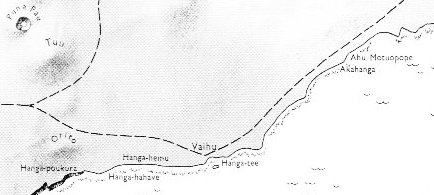And at last the final page regarding line Ga2: One of the kuhane starions was Te Pou (Sirius), ... pou meaning column, pillar or post of either stone or wood. Sometimes the word is applied to a natural rock formation with postlike qualities which serves as an orientation point. The star Sirius is called Te Pou in Rapanui and functions in the same way ... a place on the southern (nighside) shore of the island somewhere to the west of Akahanga: ... The dream soul went on and came to Te Piringa Aniva. She named the place 'Te Piringa Aniva A Hau Maka O Hiva'. Again the dream soul went on her way and reached Te Pei. She named the place 'Te Pei A Hau Maka O Hiva'. The dream soul went on and came to Te Pou. She named the place 'Te Pou A Hau Maka O Hiva'. The dream soul went on and came to Hua Reva. She named the place 'Hua Reva A Hau Maka O Hiva'. The dream soul went on and came to Akahanga. She named the place 'Akahanga A Hau Maka O Hiva'...
At the opposite sunny (northern) side of the island was the residence of the Sun King, at the bay of Anakena, to the west of the mountain Auhepa: ... The dream soul went to the other side of the mountain Hau Epa. As soon as the dream soul looked around, she saw the sand (beach), which was very white and light. She remained there and explored everything. After she had looked around carefully, the dream soul of Hau Maka said, 'Ah! This is the place that will serve as a residence for the king. She named the place 'Oromanga A Hau Maka O Hiva' and also named the neighboring bay 'Hanga Moria One A Hau Maka O Hiva' ...
With Sirius together with the Sun in early July (Anakena), perhaps at Ga2-11, we should count 183 glyphs ahead or in the opposite direction in order to find Sirius at his nightside point in the sky:
Possibly the Gregorian calendar was designed to begin not when Sirius was outshone by the Sun but when Sirius was without any such competition.
However, the very special Gb6-20 - which I earlier have deduced ought to represent Sirius - is not half a year distant but a whole year distant. Gb6-20 (402) - Ga2-11 (41) = 361. Counting in the opposite direction: Ga2-11 (41 + 471) - Gb6-20 (402) = 110 (= 471 - 361). But we should count days:
Heliacal Sirius appears to be present in the text in June 30 (Gb6-20) and therefore possibly also in Ga2-7, with the 'fishhook' at the end of a following 5-night period:
... the seasonal cycle, throughout the ancient world, was the foremost sign of rebirth following death, and in Egypt the chronometer of this cycle was the annual flooding of the Nile. Numerous festival edifices were constructed, incensed, and consecrated; a throne hall wherein the king should sit while approached in obeisance by the gods and their priesthoods (who in a crueler time would have been the registrars of his death); a large court for the presentation of mimes, processions, and other such visual events; and finally a palace-chapel into which the god-king would retire for his changes of costume ... ... Pliny wants to assure us that 'the whole sea is conscious of the rise of that star, as is most clearly seen in the Dardanelles, for sea-weed and fishes float on the surface, and everything is turned up from the bottom'. He also remarks that at the rising of the Dog-Star the wine in the cellars begins to stir up and that the still waters move ... ... the modern Homo occidentalis is bound to shrink back from the mere idea that the Nile represented a circle, where 'source' and 'mouth' meet, so that there is nothing preposterous in the notion that a Canopic mouth can be found in the geographical North ... ... It is the only star known to us with absolute certitude in the Egyptian records - its hieroglyph, a dog, often appearing on the monuments and temple walls throughout the Nile country. Its worship, chiefly in the north, perhaps, did not commence till about 3285 B.C., when its heliacal rising at the summer solstice marked Egypt's New Year and the beginning of the inundation, although precession has now carried this rising to the 10th of August. At that early date, according to Lockyer, Sirius had replaced γ Draconis as an orientation point, especially at Thebes, and notably in the great temple of Queen Hatshepsu, known to-day as Al Dēr al Bahāri, the Arabs' translation of the modern Copt's Convent of the North. Here it was symbolized, under the title of Isis Hathor, by the form of a cow with disc and horns appearing from behind the western hills ... ... Its heliacal rising 400 years before our era, corresponded with the sun's entrance into the constellation Leo, that marked the hottest time of the year, and this observation, originally from Egypt, taken on trust by the Romans, who were not proficient observers, and without condsiderations to its correctness for their age and country, gave rise to their dies canicularie, the dog days, and the association of the celestial Dog and Lion with the heat of midsummer. The time and duration of these days, although not generally agreed upon in ancient times, any more than in modern, were commonly considered as beginning on the 3d of July and ending on the 11th of August, for such were the time and period of the unhealthy season of Italy, and all attributed to Sirius ... | ||||||||||||||||||||||||||||||||||||||||||||||||||||||||||||||||||||||||||||||||||||||||||||||||||||||||||||||||||||||||||||||||||||||||||||||||||||||||||||||||||||||||||||||||||||||||||












